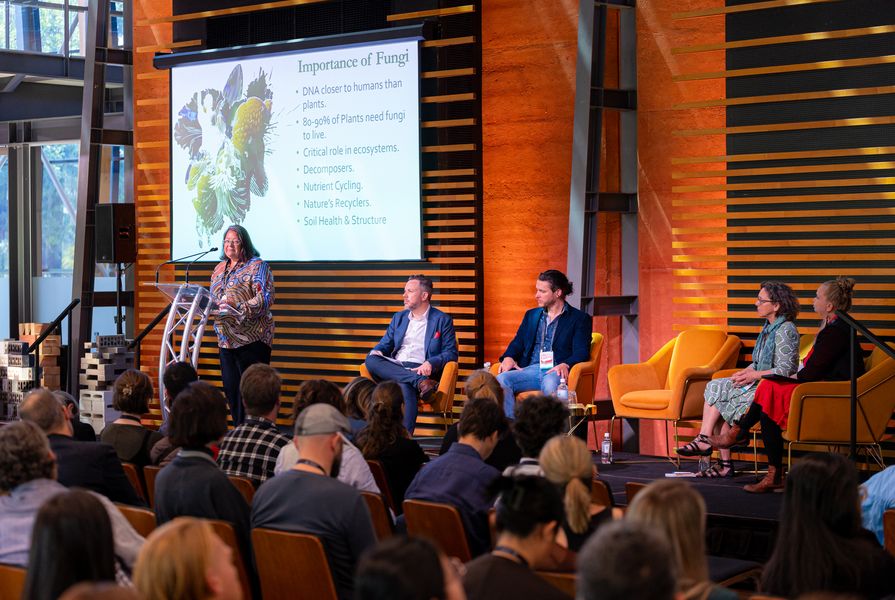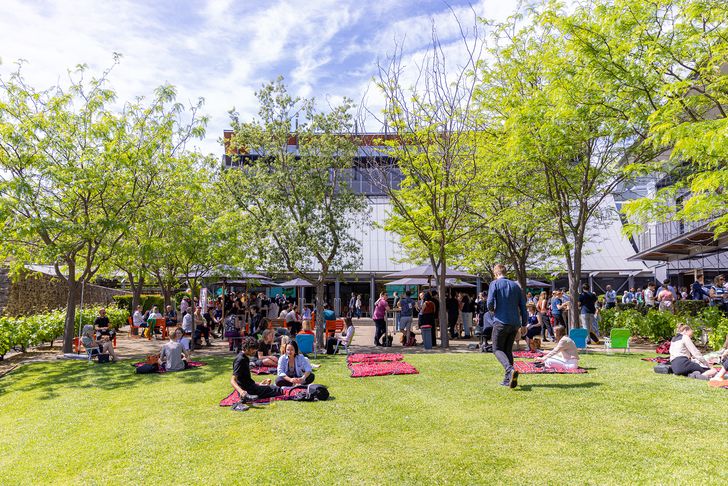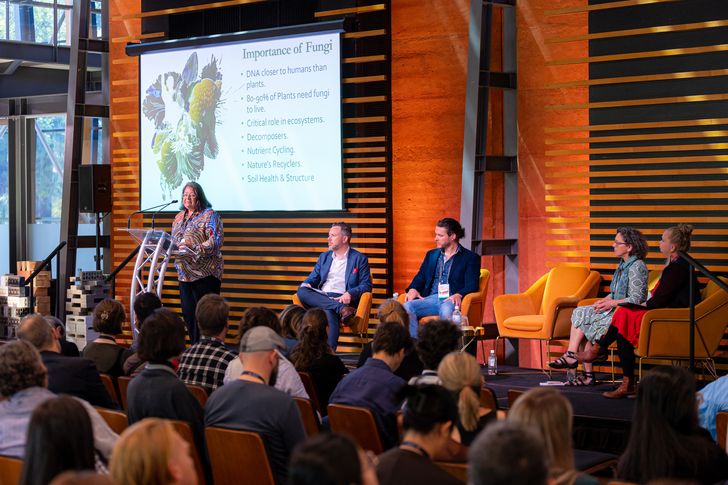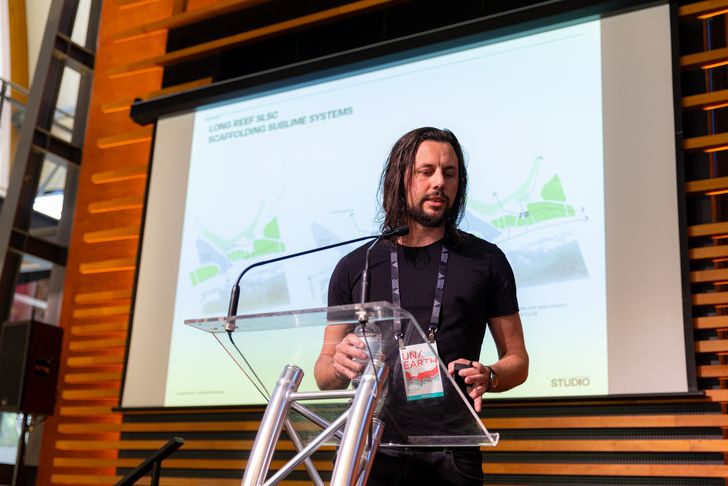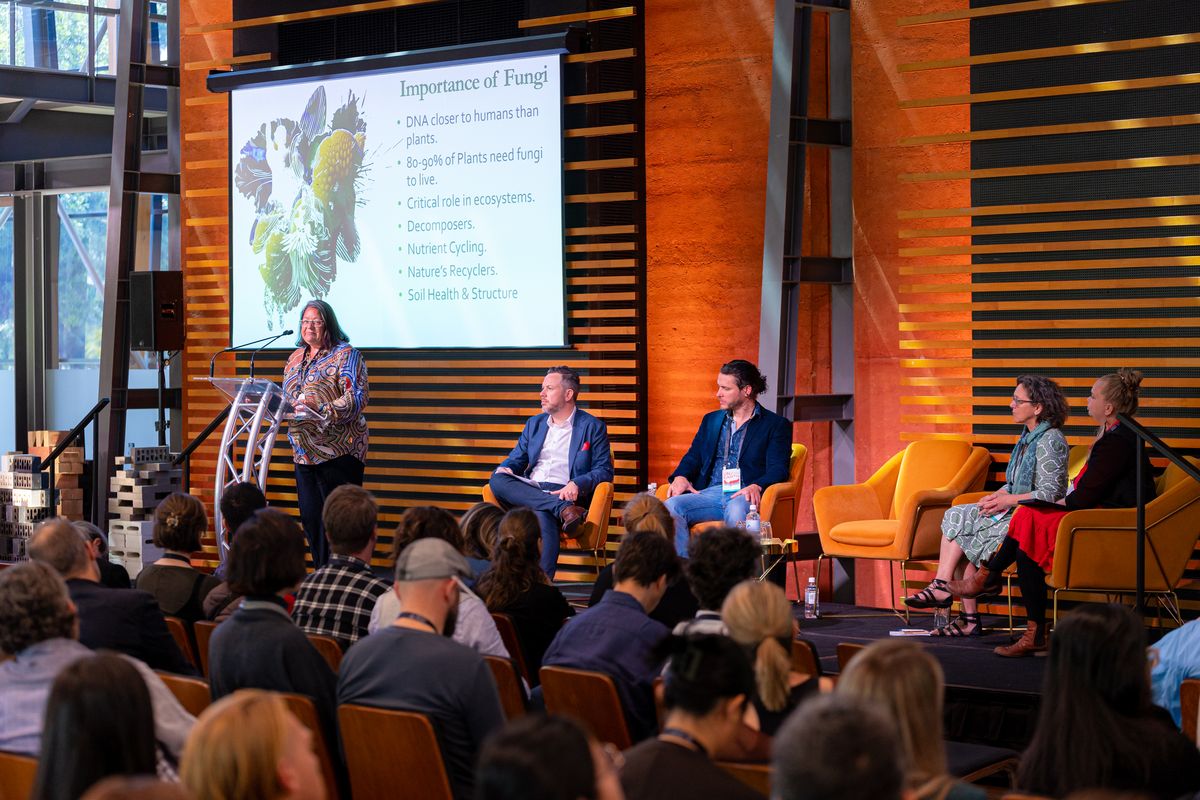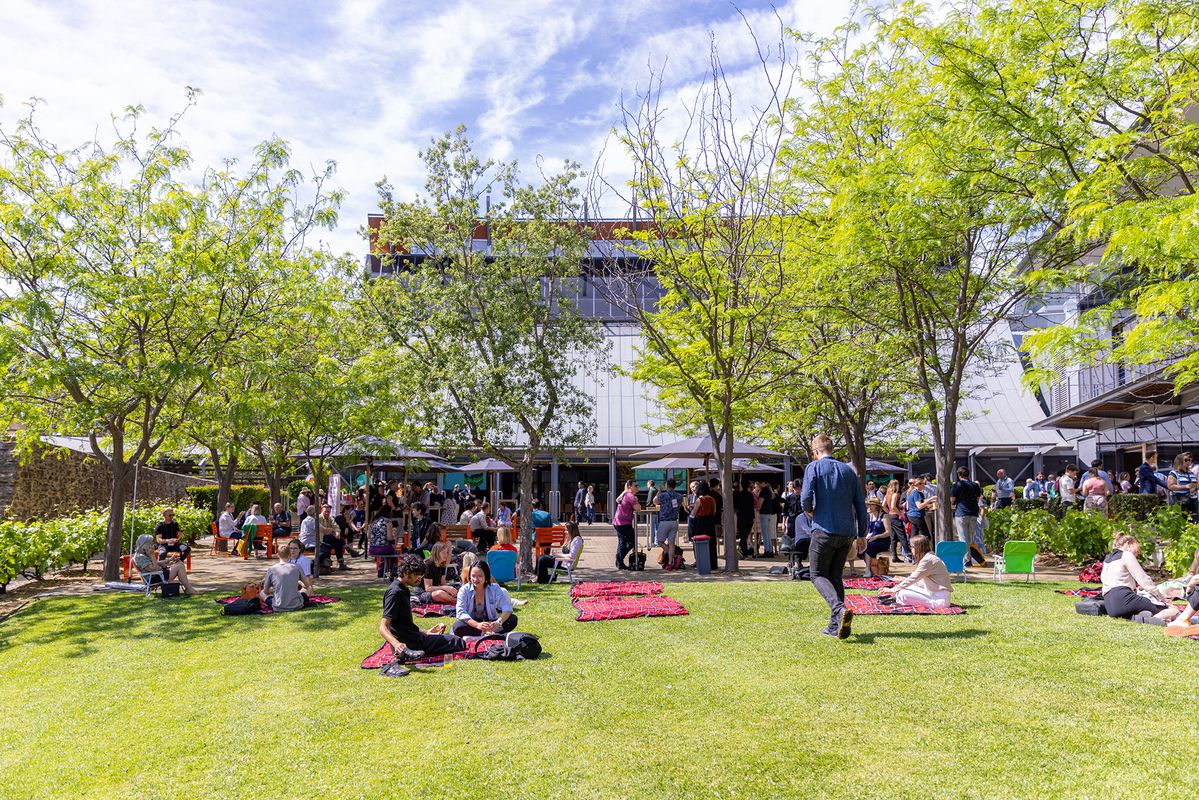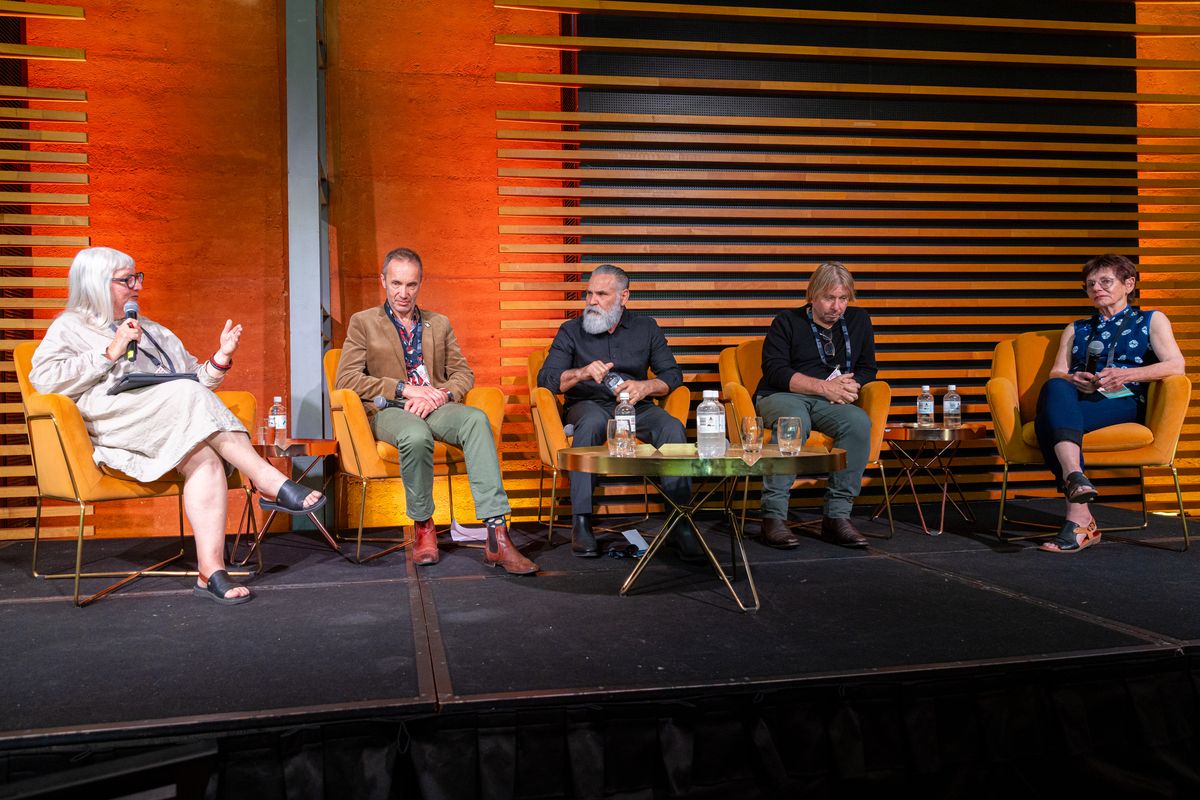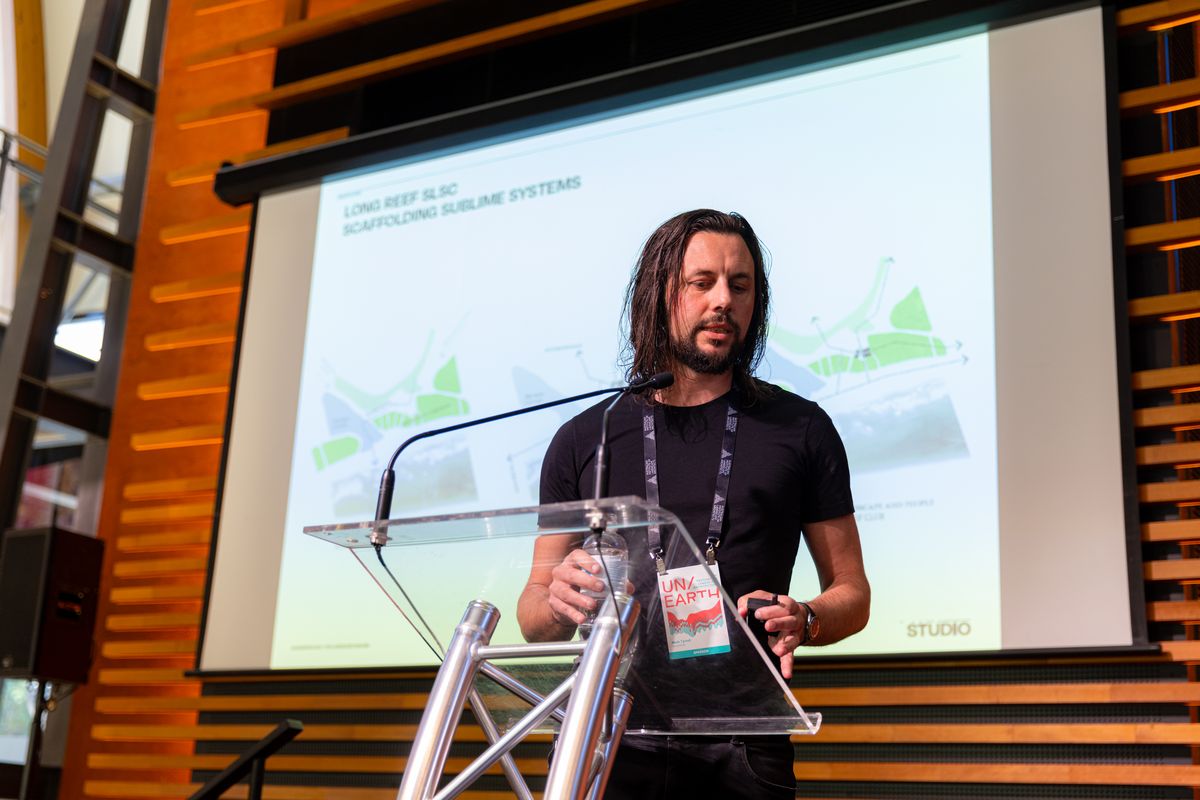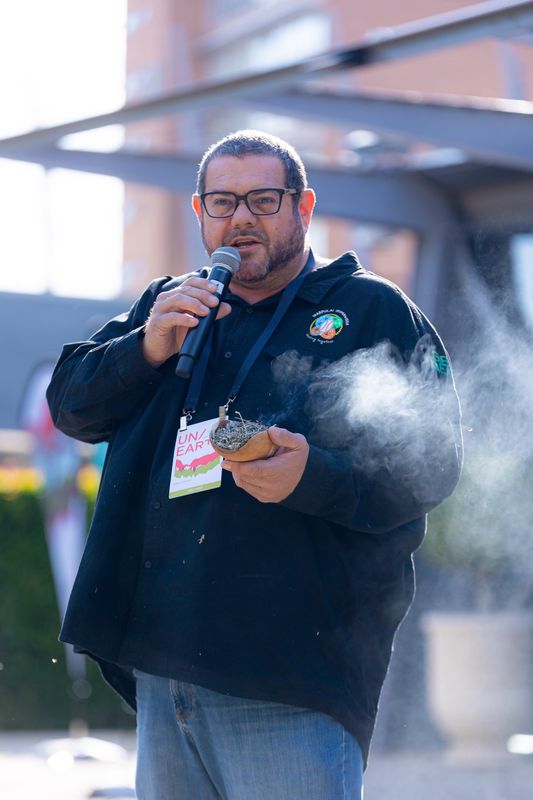“Deep Earth,” “Raw Earth,” “Fertile Earth” and “Subterranean Earth” were the themes that shaped the 2023 Festival of Landscape Architecture, “Un/Earth,” held in Tarntanya/Adelaide on the lands of the Kaurna people. Curated by Lyndon Slavin, Tanya Court, Scott Hawken and Gemma Kleinig in collaboration with cultural advisors Uncle Jeffrey Newchurch and Aunty Merle Simpson, the event aimed to draw attention to “the worlds beneath us, through exploration of the physical and metaphoric soil horizons upon which landscape architecture practice is founded.”
I have attended most of the AILA festivals over the past nine years, including last year’s edition, “Country.” This year’s edition struck me with four key learnings.
Kaurna Ngarrindjeri Yankunytjatjara man Allan Sumner opened the presentations on the second day of the festival with a Welcome to Country performed at the National Wine Centre of Adelaide.
Image: Frankie The Creative
1. The importance of building relationships, listening and good process
In pursuit of progress and the delivery of outcomes, designers often neglect the communities, individuals and places who are involved with and are impacted by our work, leading to projects that fail to reflect their voices and needs. Instead of genuine efforts to understand the community and our collaborators, consultation and engagement processes can be seen as formalities. Uncle Jeffrey Newchurch and AILA Cultural Ambassador Tommy Day criticized this superficial engagement, emphasizing that First Nations groups are tired of their involvement being seen as a “value add.” Day urged designers to stop coming to First Nations groups with preconceived ideas, and instead to come with an open heart, a willingness to understand, and a respect for cultural processes and timelines.
Kim Mahood spoke about her work collaborating with Indigenous communities to map Country and how she measures the success of a project by how quickly the community takes the lead. Meanwhile, Rodney Welch and Warwick Keates shared the collaborative journey of the Yitpi Yartapuultiku project that will create a new Aboriginal Culture Centre in Port Adelaide’s centre. Traditional Owners have been involved from the project’s inception, enabling meaningful collaboration, shared ownership and the delivery of an outcome that serves the community. Keates’s reflection – that his role on the project was to be an instrument for the translation of ideas, and that true listening requires us to de-centre ourselves – was particularly compelling.
The presentations created a firm sense of how crucial trust and a safe, welcoming environment are for effective collaboration, shared ownership, good outcomes and the ongoing custodianship of projects. As designers, we must take responsibility for advocating for good processes over outcomes to ensure the well-being of the community, empower Traditional Owners, and promote positive ecological outcomes.
The session on “Co-Mapping on Country / Yitpi Yartapuultiku” examined the collaborative processes intrinsic to engaging with First Nations Communities. The panel was moderated by Gini Lee (far right) with panelists (left to right) Warwick Keates, Rodney Welch, Greg Grabasch and Kim Mahood.
Image: Frankie The Creative
2. Connection, belonging and responsibility
Alison Page spoke about a growing societal craving for belonging and how this is manifesting as an obsession with real estate and individual ownership that is necessitating division of land and resources – ironically and tragically, resulting in further disconnection. Page contrasted this with an Indigenous perspective characterised by a deep knowledge of and responsibility for the landscape and its inhabitants and systems, where humans and non-humans have equal status.
Joshua Zeunert and Saline Verhoeven discussed how disconnection from agricultural landscapes and food production is contributing to the issue of food waste and global food shortages. By reconnecting people with food landscapes, designers can promote understanding and respect for the food and food production processes that can lead to more resilient futures.
Across the presentation sessions, the importance of considering and working with deep time was a common thread that emphasized designers’ – and humanity’s – responsibility to something greater than ourselves. “The world isn’t just there for me,” said Greg Grabasch, “You’re only going to be here for a short amount of time, so remember that when you practise.”
As the talks unfolded, the sense that true belonging, connection and symbiotic relationships emerge from a deep understanding of and care for place was amplified. As designers and people, we need to shift away from a mindset that values dominance, and instead think about what personal responsibilities we have to ecology, community and the future.
Held at the National Wine Centre of Adelaide, the 2023 Festival of Landscape Architecture explored the geologic, mineral, and organic processes that have shaped the earth and its ecosystems.
Image: Frankie The Creative
Kim Mahood spoke about her work collaborating with Indigenous communities to map Country.
Image: Frankie The Creative
3. Working with systems
Top-down approaches that aim to control existing systems have led to the destruction of our ecological, social, and cultural environments, demanding excessive effort, energy and resources. Zeunert and Verhoeven talked about the detrimental impacts of industrial agriculture, Aziza Chaouni highlighted the desertification caused by the damming of the Draa River in Morocco, and Page discussed the negative impacts of the imposition of colonial knowledge systems over Indigenous ones.
Mark Tyrrell and Chaouni showcased projects integrating landscape systems at various scales. Tyrrell’s practice has developed a systems-based strategic plan for Sydney that informs all of its projects, including the recently completed Long Reef Surf Life Saving Club which uses wastewater for dunal system reinforcement and Western Sydney Parklands where the landscape systems shape the site development. Chaouni’s music school project applies traditional knowledge to desert landscape areas and harnesses wind and water to shape physical outcomes. Page’s project demonstrated the important role landscape projects can play in recognizing what has come before in a process of truth telling.
Zeunert spoke of the governmental systems and policy that reinforce the monoculture of agricultural landscapes, urging landscape architects to work with farmers to develop new agricultural strategies and systems. Verhoeven proposed projects that leverage existing social, infrastructural and environmental systems.
Understanding and working with the systems of a place – social, ecological, economic – allows us to harness their inherent energy to create sustainable outcomes. The speakers advocated for an approach that allows systems to function effectively, enabling complex, self-organising processes without constant, resource-intensive interventions.
Indigenous fungi specialist and Arrernte woman Sherie Bruce spoke about the role of fungi in healthy ecosystems as part of the session titled “Moss, Mycelia and Micro-ecologies.”
Image: Frankie The Creative
In the session titled “Sensitivity, Brutality and Metropolitan Earthworks,” Mark Tyrrell of Tyrrellstudio discussed the studio’s design for Long Reef Surf Life Saving Club and Western Sydney Parklands.
Image: Frankie The Creative
4. Moving beyond the binary
This theme was widely explored in reference to our physical world, the way we think and the way we practise. “Somewhere between the ship and the shore is where our shared identity lies,” stated Alison Page, a sentiment that was expanded upon by microbiologist Jake Robinson’s potent observation that “all the nature we can see depends on the nature we can’t see.”
Page spoke of the Dreaming, challenging binary perceptions with Indigenous ancestral concepts that blur the distinctions between above and below, humans and nature. She also reminded us that Indigenous cultures in Australia do not traditionally distinguish between disciplines which allows for an integrated approach to problem-solving. Robinson and Sherie Bruce emphasized the vital connecting role that often-overlooked microorganisms play in sustaining ecosystems by linking the visible and the invisible, and Marilu Melo Zurita challenged the notion of “sub terra nullius” that is allowing large tunnelling projects to thrive.
Across the presentations, it became increasingly clear that as we navigate times of growing uncertainty we need to move beyond binary thinking and acknowledge complexity, unpredictability and the connectedness of all things.
The elephants in the room
Events like this year’s AILA Festival do not exist in a vacuum, instead they form an important part of the social and cultural landscape that shape how we interact with the world.
With this in mind, two significant events should have been acknowledged at the start of the festival – last year’s AILA Festival “Country” and the recent Voice to Parliament referendum. Last year’s AILA Festival “Country” had a profound impact on the profession and festival attendees. While efforts to implement lessons from the 2022 festival edition were evident throughout “Un/Earth,” this previous edition was not directly addressed. This felt like a missed opportunity to draw out key learnings, a full year on. With the festival occurring in the week after the Voice to Parliament referendum, it was a topic at the forefront of delegates’ minds, deeply affecting how they engaged with the event.
Generating conversation
While the festival’s thematic sessions were planned well with a line-up of speakers that offered multiple perspectives, the essence of a conference exists in the interactions between the unique group of speakers and delegates that come together to discuss a topic. Unfortunately, most panels this year learned towards the “Q and A” format, which left me craving a messier, more nuanced exploration of the topics.
Although the festival encouraged personal exploration, a reflection from the curators at its conclusion would have been of benefit – a chance to hear the planner’s insights and interpretation of what had just occurred. Some moments of revelation surfaced unexpectedly at various times during the sessions, and an end-of-conference reflection would have been helpful.
Following the profound impact of “Country” it was surprising that more lessons from that edition were not implemented in “Un/Earth.” “Country” challenged the AILA festival format and urged participants to engage in active self-education and refection which elevated the experience overall. While these strategies may not all have been appropriate, reverting almost entirely to the standard festival format seemed like a missed opportunity to explore a different event shape and experience.
Staying with the trouble
The key lesson I took away from “Un/Earth” is that, as designers and humans, we need to embrace complexity. While simplification is easier in the short term, it has contributed to crises including the climate change and biodiversity emergencies. Donna Haraway’s concept of “staying with the trouble” was spoken about by many speakers throughout the festival, emphasizing the need to become comfortable with navigating challenges. Our collective future is guaranteed to be messy and complex, so we better start embracing it.
The 2023 Festival of Landscape Architecture “Un/Earth” took place in Tarntanya/Adelaide from 19 to 21 October 2023.

